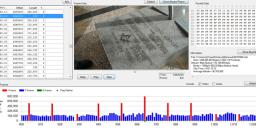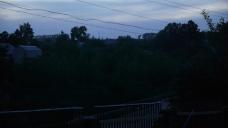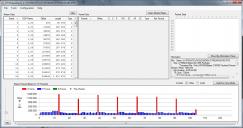
It allows to keep PV going, with more focus towards AI, but keeping be one of the few truly independent places.
-
I perceived the only difference from interlaced user ini and progressive user ini are the offset values. what are the offset values? are they what make the user ini to work for interlace or progressive?
GH1 has two separate code parts for progressive and interlaced decoders. Hence two different values for each thing. Hence different offsets.
-
@Vitaliy_Kiselev thanks, good explanation. I also did a research on wikipedia about offset on computer language and combining it with your explanation now I can understand.
things are getting interesting now for the GH1, it seems I will can do custom matrices for it, and redo the previous patches into something with proper elaboration.
-
@humpman I did the interlaced versions:
(interlaced versions, 24p is recorded in wrapped 60i)
(remember: it is experimental because I do not own the GH1, I used my previous GH2 knloledge and your achievements to develop)
(various datarates and video buffer settings to try stability, at this moment small increases in datarate to try stability first before raise it so much, details below)
(I think that small datarate increase can use the original panasonic frame buffer and frame limit)
(using your "user" settings to apply my matrices and my qp)
(with first attempt to build custom matrices for GH1)
(open the ini files to read the details, also put mouse over patch letter in PTool to get datarate and video buffer sumarize)
(using PTool 3.66d and latest GH1 1.32 firmware)
More details
The idea of small datarate increase and native 24p is to pursue stability first, I used same rounded multiplier for each recording mode and video buffer. I used long gop which is better for stability. The idea is to make it stable and an enough image quality. The Overall datarate is a little higher using same rounded multiplier, but it is lower than the buffer.
setA = 32Mbps, buffer 40
setB = 28Mbps, buffer 33.5
setC = 24Mbps, buffer 28
setD = 40Mbps, buffer 50
a little lower versions, using the buffer value to calculate the datarate rounded multiplier:
setG = 30Mbps, buffer 40
setH = 25Mbps, buffer 33.5
setI = 21Mbps, buffer 28
setJ = 38Mbps, buffer 50
Remember: this is experimental, it was done carefully but I do not own the GH1, use at your own risk!!!
the first upload is gop12 for 24p, gop12 for 25p, gop30 for 60p, gop24 for 50p
the second upload is gop15 for 24p, gop 13 for 25p, gop30 for 60p, gop26 for 50p (panasonic default)

 apefos_gh1_ini_user_interlaced.zip4K
apefos_gh1_ini_user_interlaced.zip4K
 apefos_gh1_ini_user_interlaced_gop.zip4K
apefos_gh1_ini_user_interlaced_gop.zip4K -
@humpman I did the progressive versions:
(native 24p for 1080, also custom matrices for 1080p and 720p)
(remember: it is experimental because I do not own the GH1, I used my previous GH2 knloledge and your achievements to develop)
(various datarates and video buffer settings to try stability, at this moment small increases in datarate to try stability first before raise it so much, details below)
(I think that small datarate increase can use the original panasonic frame buffer and frame limit)
(using your "user" settings to apply my matrices and my qp)
(with first attempt to build custom matrices for GH1 1080p and 720p)
(open the ini files to read the details, also put mouse over patch letter in PTool to get datarate and video buffer sumarize)
(using PTool 3.66d and latest GH1 1.32 firmware)
More details
The idea of small datarate increase and native 24p is to pursue stability first, I used same rounded multiplier for each recording mode and video buffer. I used long gop which is better for stability. The idea is to make it stable and an enough image quality. In each patch there are lower 720p datarate in the other recording modes also. The Overall datarate is a little higher using same rounded multiplier, but it is lower than the buffer.
setA = 32Mbps, buffer 40
setB = 28Mbps, buffer 33.5
setC = 24Mbps, buffer 28
setD = 40Mbps, buffer 50
a little lower versions, using the buffer value to calculate the datarate rounded multiplier:
setG = 30Mbps, buffer 40
setH = 25Mbps, buffer 33.5
setI = 21Mbps, buffer 28
setJ = 38Mbps, buffer 50
Remember: this is experimental, it was done carefully but I do not own the GH1, use at your own risk!!!
the progressive patches are gop12 for 24p, gop12 for 25p, gop30 for 60p, gop24 for 50p

 apefos_gh1_ini_user_progressive.zip4K
apefos_gh1_ini_user_progressive.zip4K -
This video shows 32mbps progressive on GH1 working good for enough quality for web upload to youtube and vimeo, for better comparison, download the video, playback and freeze it to perceive differences (feedbacks about latest progressive patches in post above with custom matrices are welcome):
-
I still use a batch of gh1's for multi camera set ups, so it's quite interesting what @humpman is sharing in this thread. But @apefos, if you don't have a camera to test with it seems to me all this posting about your patches is muddying the waters in an otherwise very interesting thread? Just my 2 cents.
-
Yep, it is much better idea to download IDA and move to another level. If you want to help.
-
@Vitaliy_Kiselev I found information about IDA, will have a look.
@eyenorth you are correct, without the camera to do tests I cannot try the patches, but to be honest I am liking this because I can develop things using my previous knowledge and improve it before the hurting moment of waiting firmware upgrade... Good ideas are in my mind and we can do them working together, a colaborative work.
The new idea is: to develop a hybrid patch with 24p wrapped in 60i for a more reliable 1080 24p recording without bugs with custom matrices and custom quantization qp and also custom matrices and custom quantization qp for 720p60 and 720p50 progressive. The only extra work is to remove pulldown in post production, but if it is more reliable so this approach can be interesting, good 24p and good 60p.
this is my first attempt to do it, I ask for @humpman help to read the hybrid user ini file and the sete ini that I did and correct them if needed. If the offsets are different for progressive and interlaced then we can do the hybrid user ini file. I perceived that the user section can hold 10 patches so I removed some unused. Also I put the letter i in the interlaced patches name and the letter p in the progressive patches name. I do not know if I can change the patch name, but when the patches have the same name the sete.ini does not show both interlaced and progressive...
In few words: can I change the patch name in the user ini file?
(I downloaded and did a first look at IDA, it seems that the patch name can be customized, in IDA examples there is "my patch" and "other patch" in patch names...if this is correct my hybrid user ini will work)
In the need of help to develop this idea, please see:

 interlaced+progressive.zip1K
interlaced+progressive.zip1K -
used GH1 bodies are around $100 now!
-
the native 24p big problem seems to be the empty frames, not the stop recording. now I understand the big bug. the Blackout-Powell patch try to solve this, but maybe it will be better to keep 24p into the 60i wrapper...
I found this image in dvxuser forum, the camera is not keeping the same gop length, sometimes the gop is 12 sometimes the gop is 13. this seems to be a gop problem. maybe this could be solved if the camera could keep the same gop length, maybe using gop15 ??? maybe a very large gop120 ??? or other mystery settings... this I cannot try now, it needs a camera body to do tests.
seems to be better idea to keep the 24p into the 60i wrapper and do the pulldown removal in post production, more reliable solution as I did in the hybrid sete patch, same thing humpman did in his patches. for people who shoot 25p maybe the native can work properly, but not the 24p.
using native 24p, suddenly the last P frame in a gop gets empty and next I frame is low size, gop vary between 12 and 13, see:

 24p_bug.jpg960 x 411 - 216K
24p_bug.jpg960 x 411 - 216K -
my theory for this bug is: the codec is generating a frame when there is no data from sensor, in a moment between two sensor outputs, probably the codec timing is different from the sensor timing.
the only settings in ptool I see to change is the "frame related comparison" from 30 to 24.
other possibly settings are the enconder setting 1, 2 and 3, and some constants, which maybe can change something about this issue.
I cannot see anything else to do. raise datarate is not related to timing.
this would need long long time research using IDA without a certainty that it can be done.
better keep the 24p inside the 60i wrapper and use the sete and setf hybrid patches below, they have custom matrices and QP for 1080 and 720.
for 25p maybe the progressive patches in previous post can work, because timing in 25p and 50i are similar.
only difference between setE and setF is the Overall bitrate, in setE it is 36Mbps, in setF it is 34Mbps, small difference to try stability and perceive the best for avoiding stop recording problem. Both are 32Mbps patches. Both have also the 720p H and L lower datarates.
To try increasing the bitrate more than 32Mbps It would be better have the camera to do tests, so I think my job is done for now...

 hybrid_e_f.zip2K
hybrid_e_f.zip2K -
-
no, I do not have the disassembled firmware, but to be honest, keep 24p in 60i wrapper is not big problem, just need a post production pulldown. It would be hard work to pursue the native 24p with big chances to be just a waste of time...
the patches I did was using the humpman user ini file which is enough for building custom matrices and qp. he did the interlaced and the progressive user ini files and I developed the hybrid user ini (interlaced + progressive) with his revision and approval.
-
OK, get it in this case and learn IDA Pro. All other things are mostly waste of time.
-
This topic is not about settings or patches.
-
I know its pointless but had to do it. GH1 GM1 Both same setting and same lens: Panas 20mm 1.7 at f2.2 shooter 100 iso 3200 :) Standard all -2 No si-fi (day with kids:)) I have same hand held shoots from forest in day light with both cams in lower iso if same one interested :) Stable from 29 May patch 25fps
Edit: ups was going to upload on vimeo
Howdy, Stranger!
It looks like you're new here. If you want to get involved, click one of these buttons!
Categories
- Topics List23,980
- Blog5,725
- General and News1,352
- Hacks and Patches1,152
- ↳ Top Settings33
- ↳ Beginners255
- ↳ Archives402
- ↳ Hacks News and Development56
- Cameras2,362
- ↳ Panasonic992
- ↳ Canon118
- ↳ Sony156
- ↳ Nikon96
- ↳ Pentax and Samsung70
- ↳ Olympus and Fujifilm100
- ↳ Compacts and Camcorders300
- ↳ Smartphones for video97
- ↳ Pro Video Cameras191
- ↳ BlackMagic and other raw cameras115
- Skill1,960
- ↳ Business and distribution66
- ↳ Preparation, scripts and legal38
- ↳ Art149
- ↳ Import, Convert, Exporting291
- ↳ Editors191
- ↳ Effects and stunts115
- ↳ Color grading197
- ↳ Sound and Music280
- ↳ Lighting96
- ↳ Software and storage tips266
- Gear5,417
- ↳ Filters, Adapters, Matte boxes344
- ↳ Lenses1,580
- ↳ Follow focus and gears93
- ↳ Sound498
- ↳ Lighting gear314
- ↳ Camera movement230
- ↳ Gimbals and copters302
- ↳ Rigs and related stuff273
- ↳ Power solutions83
- ↳ Monitors and viewfinders340
- ↳ Tripods and fluid heads139
- ↳ Storage286
- ↳ Computers and studio gear560
- ↳ VR and 3D248
- Showcase1,859
- Marketplace2,834
- Offtopic1,319







